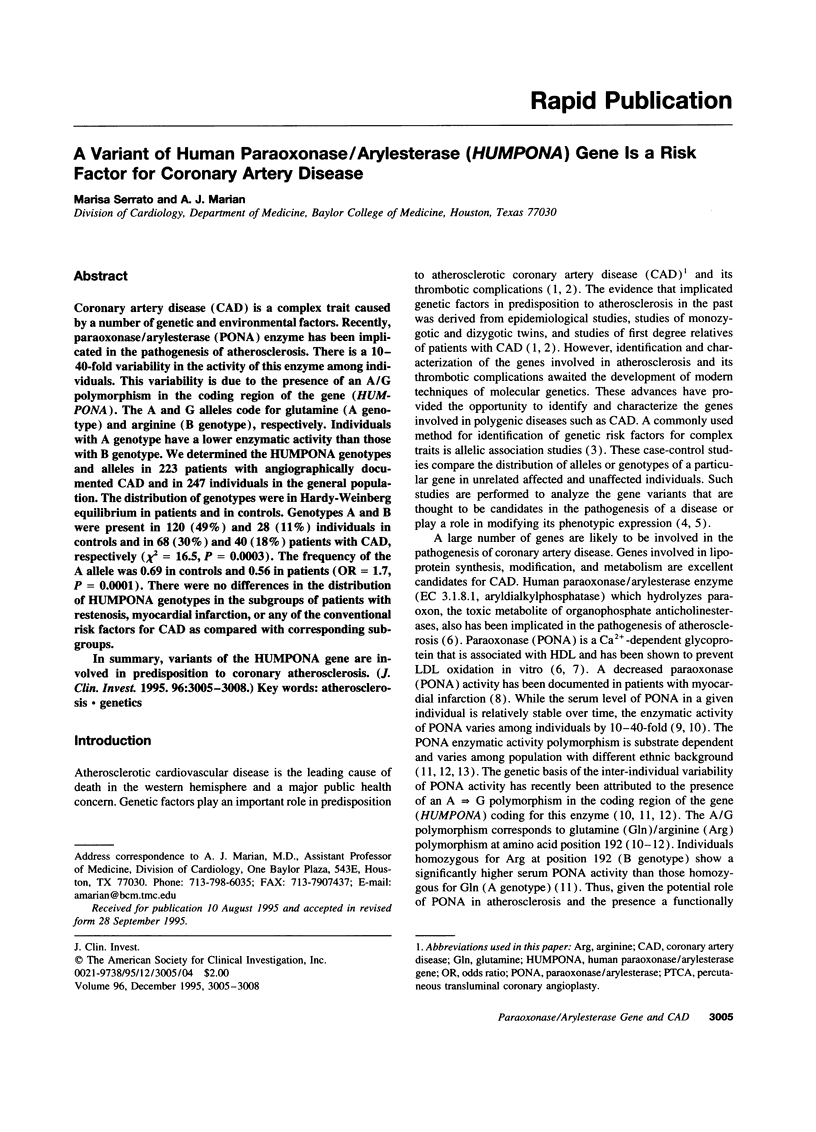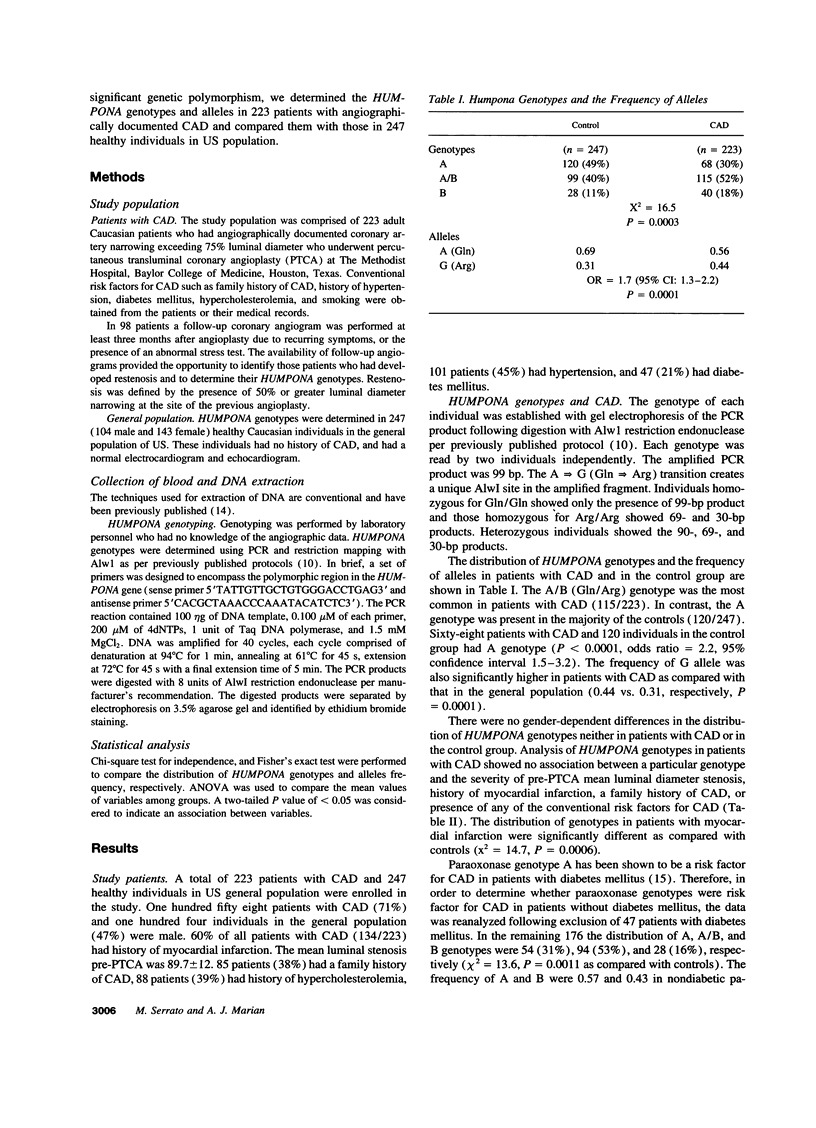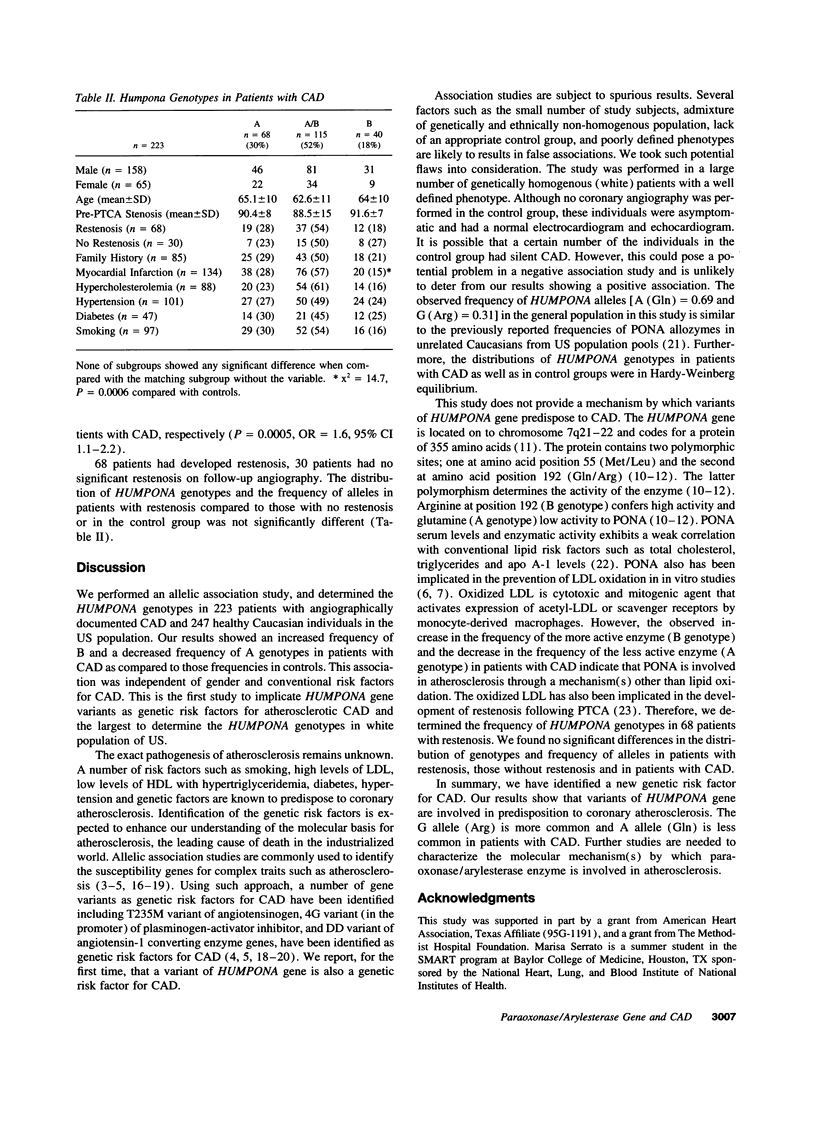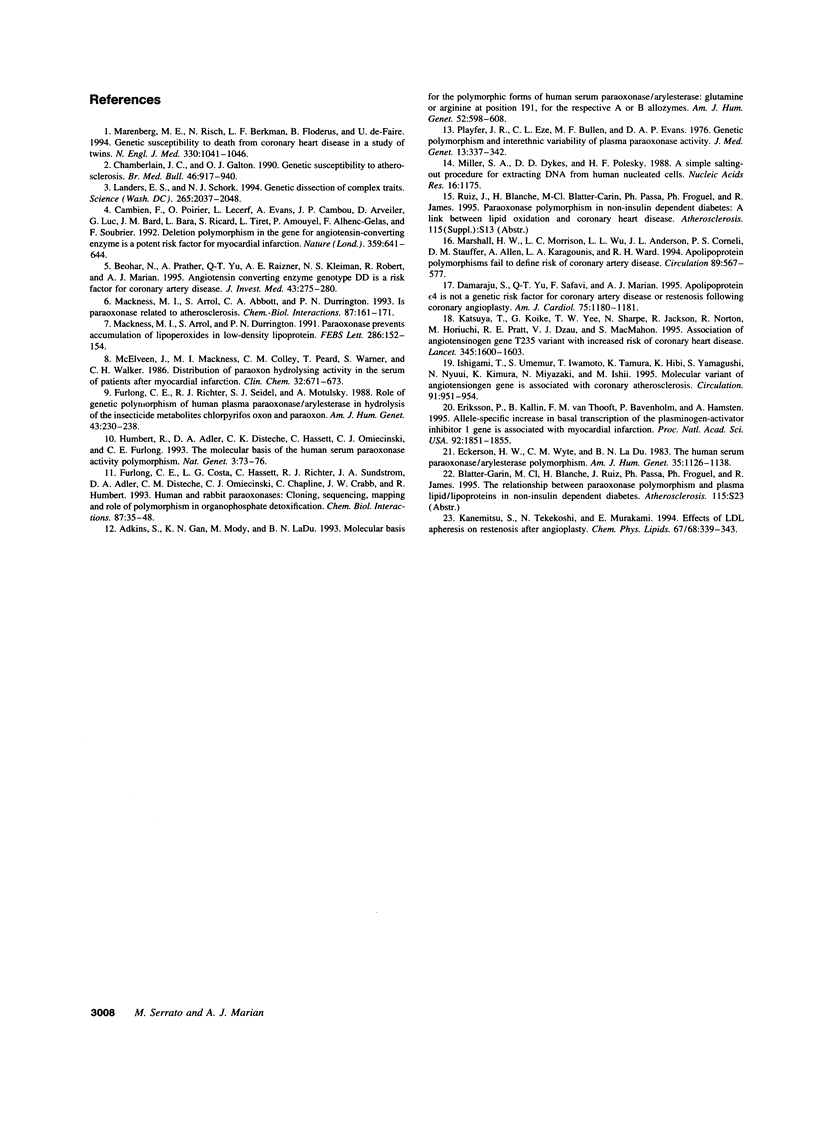Abstract
Coronary artery disease (CAD) is a complex trait caused by a number of genetic and environmental factors. Recently, paraoxonase/arylesterase (PONA) enzyme has been implicated in the pathogenesis of atherosclerosis. There is a 10-40-fold variability in the activity of this enzyme among individuals. This variability is due to the presence of an A/G polymorphism in the coding region of the gene (HUMPONA). The A and G alleles code for glutamine (A genotype) and arginine (B genotype), respectively. Individuals with A genotype have a lower enzymatic activity than those with B genotype. We determined the HUMPONA genotypes and alleles in 223 patients with angiographically documented CAD and in 247 individuals in the general population. The distribution of genotypes were in Hardy-Weinberg equilibrium in patients and in controls. Genotypes A and B were present in 120 (49%) and 28 (11%) individuals in controls and in 68 (30%) and 40 (18%) patients with CAD, respectively (chi squared= 16.5, P= 0.0003). The frequency of the A allele was 0.69 in controls and 0.56 in patients (OR= 1.7, P= 0.0001). There were no differences in the distribution of HUMPONA genotypes in the subgroups of patients with restenosis, myocardial infarction, or any of the conventional risk factors for CAD as compared with corresponding subgroups. In summary, variants of the HUMPONA gene are involved in predisposition to coronary atherosclerosis.
Full text
PDF



Selected References
These references are in PubMed. This may not be the complete list of references from this article.
- Adkins S., Gan K. N., Mody M., La Du B. N. Molecular basis for the polymorphic forms of human serum paraoxonase/arylesterase: glutamine or arginine at position 191, for the respective A or B allozymes. Am J Hum Genet. 1993 Mar;52(3):598–608. [PMC free article] [PubMed] [Google Scholar]
- Beohar N., Damaraju S., Prather A., Yu Q. T., Raizner A., Kleiman N. S., Roberts R., Marian A. J. Angiotensin-I converting enzyme genotype DD is a risk factor for coronary artery disease. J Investig Med. 1995 Jun;43(3):275–280. [PubMed] [Google Scholar]
- Cambien F., Poirier O., Lecerf L., Evans A., Cambou J. P., Arveiler D., Luc G., Bard J. M., Bara L., Ricard S. Deletion polymorphism in the gene for angiotensin-converting enzyme is a potent risk factor for myocardial infarction. Nature. 1992 Oct 15;359(6396):641–644. doi: 10.1038/359641a0. [DOI] [PubMed] [Google Scholar]
- Chamberlain J. C., Galton D. J. Genetic susceptibility to atherosclerosis. Br Med Bull. 1990 Oct;46(4):917–940. doi: 10.1093/oxfordjournals.bmb.a072446. [DOI] [PubMed] [Google Scholar]
- Damaraju S., Yu Q. T., Safavi F., Marian A. J. Apolipoprotein epsilon 4 is not a genetic risk factor for coronary artery disease or restenosis after percutaneous transluminal coronary angioplasty. Am J Cardiol. 1995 Jun 1;75(16):1181–1183. doi: 10.1016/s0002-9149(99)80756-5. [DOI] [PubMed] [Google Scholar]
- Eckerson H. W., Wyte C. M., La Du B. N. The human serum paraoxonase/arylesterase polymorphism. Am J Hum Genet. 1983 Nov;35(6):1126–1138. [PMC free article] [PubMed] [Google Scholar]
- Eriksson P., Kallin B., van 't Hooft F. M., Båvenholm P., Hamsten A. Allele-specific increase in basal transcription of the plasminogen-activator inhibitor 1 gene is associated with myocardial infarction. Proc Natl Acad Sci U S A. 1995 Mar 14;92(6):1851–1855. doi: 10.1073/pnas.92.6.1851. [DOI] [PMC free article] [PubMed] [Google Scholar]
- Furlong C. E., Costa L. G., Hassett C., Richter R. J., Sundstrom J. A., Adler D. A., Disteche C. M., Omiecinski C. J., Chapline C., Crabb J. W. Human and rabbit paraoxonases: purification, cloning, sequencing, mapping and role of polymorphism in organophosphate detoxification. Chem Biol Interact. 1993 Jun;87(1-3):35–48. doi: 10.1016/0009-2797(93)90023-r. [DOI] [PubMed] [Google Scholar]
- Furlong C. E., Richter R. J., Seidel S. L., Motulsky A. G. Role of genetic polymorphism of human plasma paraoxonase/arylesterase in hydrolysis of the insecticide metabolites chlorpyrifos oxon and paraoxon. Am J Hum Genet. 1988 Sep;43(3):230–238. [PMC free article] [PubMed] [Google Scholar]
- Humbert R., Adler D. A., Disteche C. M., Hassett C., Omiecinski C. J., Furlong C. E. The molecular basis of the human serum paraoxonase activity polymorphism. Nat Genet. 1993 Jan;3(1):73–76. doi: 10.1038/ng0193-73. [DOI] [PubMed] [Google Scholar]
- Ishigami T., Umemura S., Iwamoto T., Tamura K., Hibi K., Yamaguchi S., Nyuui N., Kimura K., Miyazaki N., Ishii M. Molecular variant of angiotensinogen gene is associated with coronary atherosclerosis. Circulation. 1995 Feb 15;91(4):951–954. doi: 10.1161/01.cir.91.4.951. [DOI] [PubMed] [Google Scholar]
- Kanemitsu S., Tekekoshi N., Murakami E. Effects of LDL apheresis on restenosis after angioplasty. Chem Phys Lipids. 1994 Jan;67-68:339–343. doi: 10.1016/0009-3084(94)90155-4. [DOI] [PubMed] [Google Scholar]
- Katsuya T., Koike G., Yee T. W., Sharpe N., Jackson R., Norton R., Horiuchi M., Pratt R. E., Dzau V. J., MacMahon S. Association of angiotensinogen gene T235 variant with increased risk of coronary heart disease. Lancet. 1995 Jun 24;345(8965):1600–1603. doi: 10.1016/s0140-6736(95)90115-9. [DOI] [PubMed] [Google Scholar]
- Lander E. S., Schork N. J. Genetic dissection of complex traits. Science. 1994 Sep 30;265(5181):2037–2048. doi: 10.1126/science.8091226. [DOI] [PubMed] [Google Scholar]
- Mackness M. I., Arrol S., Abbott C. A., Durrington P. N. Is paraoxonase related to atherosclerosis. Chem Biol Interact. 1993 Jun;87(1-3):161–171. doi: 10.1016/0009-2797(93)90038-z. [DOI] [PubMed] [Google Scholar]
- Mackness M. I., Arrol S., Durrington P. N. Paraoxonase prevents accumulation of lipoperoxides in low-density lipoprotein. FEBS Lett. 1991 Jul 29;286(1-2):152–154. doi: 10.1016/0014-5793(91)80962-3. [DOI] [PubMed] [Google Scholar]
- Marenberg M. E., Risch N., Berkman L. F., Floderus B., de Faire U. Genetic susceptibility to death from coronary heart disease in a study of twins. N Engl J Med. 1994 Apr 14;330(15):1041–1046. doi: 10.1056/NEJM199404143301503. [DOI] [PubMed] [Google Scholar]
- Marshall H. W., Morrison L. C., Wu L. L., Anderson J. L., Corneli P. S., Stauffer D. M., Allen A., Karagounis L. A., Ward R. H. Apolipoprotein polymorphisms fail to define risk of coronary artery disease. Results of a prospective, angiographically controlled study. Circulation. 1994 Feb;89(2):567–577. doi: 10.1161/01.cir.89.2.567. [DOI] [PubMed] [Google Scholar]
- McElveen J., Mackness M. I., Colley C. M., Peard T., Warner S., Walker C. H. Distribution of paraoxon hydrolytic activity in the serum of patients after myocardial infarction. Clin Chem. 1986 Apr;32(4):671–673. [PubMed] [Google Scholar]
- Playfer J. R., Eze L. C., Bullen M. F., Evans D. A. Genetic polymorphism and interethnic variability of plasma paroxonase activity. J Med Genet. 1976 Oct;13(5):337–342. doi: 10.1136/jmg.13.5.337. [DOI] [PMC free article] [PubMed] [Google Scholar]


